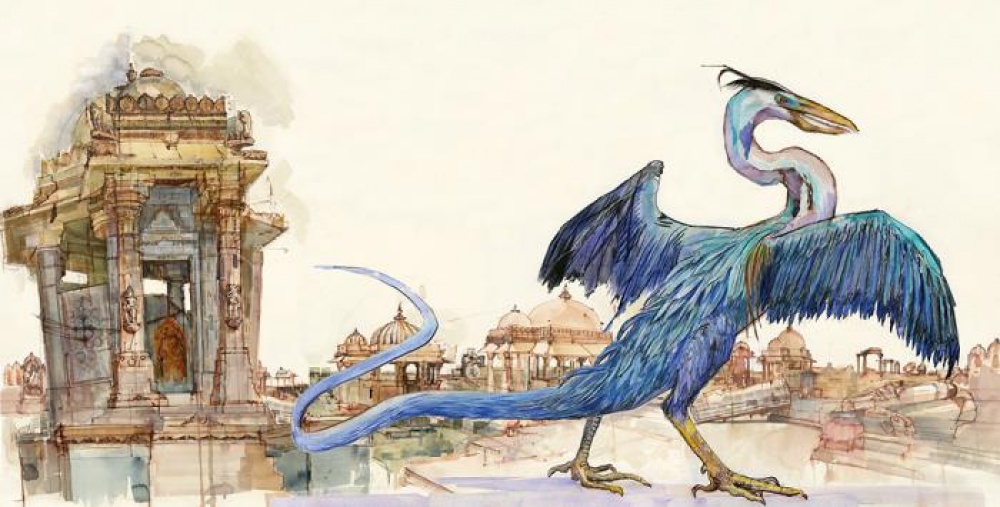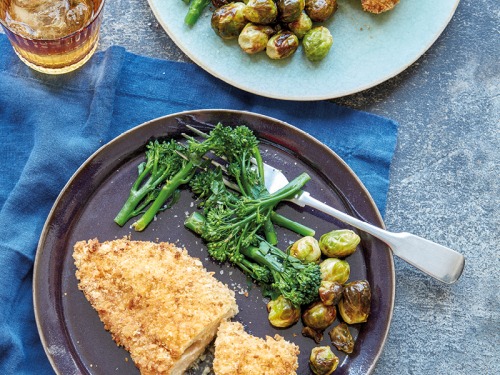Meet the Northumberland Artist Who Illustrated J.K. Rowling's Fantastic Beast and Where to Find Them

Artist turned book illustrator Olivia Lomenech Gill brought the fantastic beasts in JK Rowling’s world of Harry Potter to life – but her journey to that point (via a chance meeting with Michael Morpurgo) is a truth stranger than fiction
She’d spent most of Monday catching up on World Book Day events that had been delayed because of the Beast from the East, and now, late on Monday afternoon, she’s embroiled in the chaotic moments when her children return from school trying to unpick the story of how she ended up illustrating one of the most anticipated books (the illustrated edition of Fantastic Beasts and Where to Find Them, an adjunct to the Harry Potter series) from arguably the world’s best-known author, JK Rowling. Like any good story, the beginning of the journey isn’t necessarily the beginning.
Olivia’s mother was a classical musician, so she and her brother were brought up in a musical household. But by her teenage years, Olivia was keen to break out of what was expected of her. ‘I started doing visual arts,’ she explains: ‘painting and drawing, studying it quite seriously.’
She then took another left turn, deciding to study theatre instead of following art formally. ‘I chose theatre because it was a more holistic form of storytelling,’ she says. In school holidays she went to London, slept on friends’ floors and ran around the city doing voluntary work with various theatres – ‘I was doing five jobs at once, just to pay my rent somewhere on the outskirts of London,’ she recalls – before starting work on her degree in theatre, and later went to work in London after finishing her studies.
Although she had disavowed formal art training, Olivia was still keen to practice her love of art, even putting on exhibitions. ‘I put together a body of work, drove it down to the other end of the country, and it turned out to be enough of a success to generate enough funds to help me finish my university course,’ she explains. It also had another effect: ‘It set me up with the idea that I could work as an artist.’
For 15 years, she had a career working primarily as an artist, appearing at major London art fairs and selling her work through a handful of dealers based there, before moving back up to live in her mother’s cottage in Northumberland. ‘I couldn’t stand it in the city anymore and the cottage was here,’ she says. A few years later, Olivia married Vincent, a French paper conservator and specialist picture framer, built a studio by hand in the back garden, and started a family.
It was a chance meeting at a book festival in husband Vincent’s home of Brittany in 2009 that changed the path of Olivia’s life. There, she met acclaimed children’s author Michael Morpurgo. ‘Michael jokes it was the place he only sold six books,’ says Olivia. The organiser of the festival arranged a meeting between Olivia and Michael, and the pair began chatting. It just so happened that Michael and his wife and Olivia and Vincent were on the same ferry back home, and ended up sharing a picnic.
‘He’d seen me drawing on the ferry – because I’m always late on deadlines and was desperately trying to get some work done – and asked if he could look at the sketchbook,’ Olivia explains. ‘It wasn’t particularly good, but months later they came to an exhibition of mine, bought some work, then gave me this text.’
‘This text’ was a scrappy collection of photocopies, the story of a girl walking in the countryside. It was a draft of Where My Wellies Take Me, his children’s book that takes the form of part poetry anthology and part childhood scrapbook. Olivia read the book and was taken by it – and the offer Michael made of illustrating the work.
‘As an artist I’d always been narrative-based,’ she explains. ‘That’s not something that’s really been fashionable in the last 10 or 20 years. When Michael asked me if I’d do the book, I was aware that a lot of artists would probably really resent the idea of doing illustrative work, but for me it was exciting.’ It gave Olivia the chance to ponder a question: ‘I’ve always been doing work around stories, so what would it be like to work on an actual book with an actual text?’
She packed up her bags and travelled down to Devon, where Michael and his wife Clare used to spend their holidays, and to where they subsequently moved. ‘I camped in the garden and researched the area,’ explains Olivia, seeking inspiration for the hand-drawn illustrations. ‘I basically spent a week annoying the locals, and ended up getting taken in by somebody because it was so cold and miserable, I didn’t have a phone and I managed to write off the car.
‘It was one of those weeks where you feel crap and have a bit of a crap time, but I look back and think: “Because of the kindness of all those people, because of me throwing myself on their mercy, it made the book what it was”,’ says Olivia.
Her illustrations for Where My Wellies Take Me helped get her her next job – illustrating JK Rowling’s Fantastic Beasts and Where to Find Them, the taxonomy of creatures in the Harry Potter universe. ‘I don’t know exactly how it came about because everything to do with Harry Potter is a bit of a secret,’ says Olivia, ‘but my agent Alison Eldred got in touch with me over Christmas and New Year and said: “Can you do some sample dragons for a job? I can’t tell you what it’s for.”’
‘I sensed it was important,’ Olivia recalls. She drew a number of different dragons, which, unbeknownst to her, were passed on to Bloomsbury and JK Rowling. She got the job, but it came with a catch: ‘I wasn’t allowed to talk about it for a year, or to show anyone anything from it,’ she says.
The task was also daunting. ‘Most of the time you’re in the studio working on something, you make it, then decide if someone gets to see it or not,’ Olivia explains. ‘When you’re working on the Harry Potter books, you know there’s probably one or two people out there who are going to be looking at it.’
She was worried at first that her simplistic, low-tech illustrative technique wouldn’t be up to scratch. ‘You’re living in a world now where a lot of stuff is produced digitally,’ she says. ‘I thought: “How can I do combat with this glossy, amazing CGI with a burnt twig?”’
Another challenge was the timescale: while Olivia was working on her illustrations for the book, the blockbuster Hollywood film starring Eddie Redmayne was released. ‘I was worried that’d be really confusing for people because the book is nothing to do with the film – I haven’t seen the film,’ Olivia confesses. ‘But the publishers, and JK Rowling, were fine with it. That’s what’s amazing: the world of Harry Potter is so generous and open to interpretation.’
Yet Olivia brought her years of experience to bear on the project – and a fair few technical skills. ‘From the beginning, I just looked at it as a reference book. I went to the early zoological books from the 1550s by Conrad Gessner and Ulisse Aldrovandi, which brought together all this material and were done with wood-engraved illustrations,’ she says. She travelled to the Natural History Museum to see the original versions of both books, and to take inspiration.
‘To go back to the beginnings of Renaissance zoology was important,’ she explains. ‘Fantastic Beasts is a reference book. It’s an A–Z. It’s not a story book. The characters in it are not Harry Potter characters; they’re just archetype beasts. I was trying to divorce it as much as possible from all the actual Harry Potter books because, I realised, it’s nothing to do with Harry until he finds it in the Hogwarts Library; it really is a separate entity.’
The work was heavy lifting: many of Fantastic Beasts’ 140 pages were illustrations, and Olivia was keen that the illustrative style was a real mix. ‘If you only worked with one medium, the whole book could become a bit monotonous with page after page of the same thing,’ she explains. ‘As an artist, perhaps because I’m self-taught, I tend to use lots of different media,’ she says. ‘It seems to me that each one is good for a different job.’
Etchings or some form of printmaking make up around a third of the illustrations in Fantastic Beasts, and some of the illustrations were created in the studio which Olivia shares with her husband Vincent, on a three-tonne printing press, made of cast iron. ‘My one slight specialism is printmaking,’ she says. ‘I do copperplate etchings. I’m very lucky to have the printing press: it’s one of the few big machines in the country. But it takes a bit of planning to move it, a low loader and a HI-AB!’
The process of trying to capture a collection of mythical beasts dreamt up by an author who has fully fleshed out an entire universe of characters was surprisingly smooth. ‘We went through a period where I did rough drawings for all the beasts and very few came back with corrections,’ explains Olivia. ‘I found it quite liberating; I had free rein to do what I wanted.’
Working on Fantastic Beasts brought Olivia some interest in her local community. ‘We had lots of people come along in Belford when we did a little launch,’ she says. But the broader impact is yet to be seen. ‘It’s very early to say what impact, if any, it’s had on my life,’ she says. ‘It hasn’t made people pick up the phone and say: “Can I commission you to do this?” But I don’t think that’s how good things happen. I don’t think good things happen overnight.’
Fantastic Beasts and Where to Find Them: Illustrated Edition is published by Bloomsbury, £25









